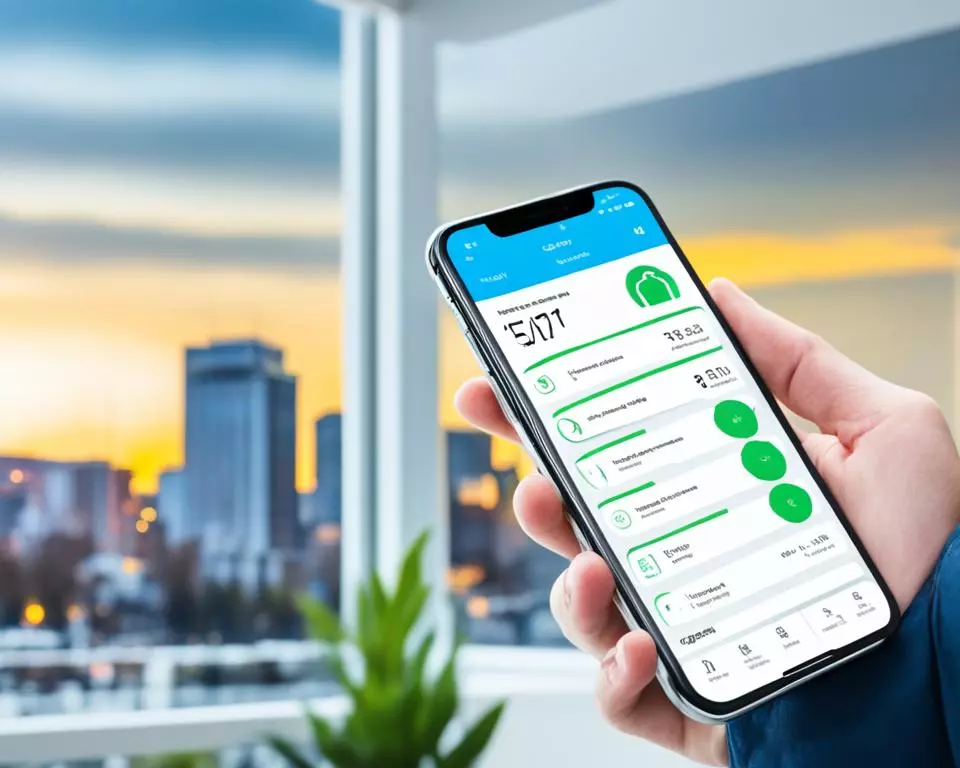Adverts
You applications for Internet of Things, or IoT, have become one of the most important innovations of the 21st century. They allow the connection and exchange of data between physical devices via the internet. This technology has been applied in several sectors, such as health, agriculture, retail It is urbanism. There are already more than 10 billion devices IoT connected globally, a number that is expected to increase to 22 billion by 2025.
Adverts
Main points covered in this article:
- What are apps for IoT
- Application areas of IoT applications
- Benefits of IoT applications
- IoT application development
- Like the IoT applications are they implemented?
What are IoT applications?
You applications for Internet of Things, or IoT, is software that acts as a communication interface between you and IoT devices. They allow you to interact with the data collected by IoT sensors and present this information in a readable and statistical way through dashboards on your devices such as smartphones, laptops or computer screens.
These applications play a fundamental role in Internet of Things, as they are responsible for analyzing and processing the collected data, facilitating decision-making and optimizing processes. With them, you can monitor the performance of your IoT devices, control their settings, and receive important alerts or notifications.
Through IoT applications, you can make the most of the potential of Internet of Things, making your life more convenient, efficient and personalized. With easy access to data collected by IoT devices, you can make informed decisions and track the performance of different aspects of your everyday life.
Adverts
Applications for IoT are the key to unlocking the potential of Internet of Things and transform the way you interact with the connected world.
Benefits of IoT applications
Using IoT applications brings a series of benefits to users. Some of the key benefits include:
- Greater control: Apps allow you to control your IoT devices remotely, offering convenience and flexibility.
- Process optimization: With access to data collected by IoT sensors, you can identify patterns, trends and opportunities for improvement, optimizing processes and increasing efficiency.
- Personalization: Applications allow you to personalize your settings and preferences, tailoring IoT devices to your individual needs and preferences.
- Ease of use: Applications are designed to be intuitive and easy to use, offering a user-friendly experience.
These are just a few examples of the benefits that IoT applications can bring. With the advancement of technology and the constant evolution of the Internet of Things, it is likely that even more advantages will emerge for users.
Application areas of IoT applications
Applications for IoT have a wide range of applications across different industries. In the area of health, they can help monitor patients, collecting behavioral data and enabling more efficient monitoring. At agriculture, these apps can be used to monitor and optimize growing processes such as light, temperature and soil moisture. At the urbanism, IoTs can be deployed on smart poles and meters, improving energy management and city infrastructure. Already in retail, IoT applications can improve inventory management, customer experience and reduce operational costs.
| Sector | applications |
|---|---|
| In health | Assist in monitoring patients and enable more efficient follow-up. |
| At Agriculture | Monitor and optimize growing processes such as light, temperature and soil moisture. |
| At the urbanism | Improve energy management and city infrastructure with the implementation of smart poles and meters. |
| At the Retail | Improve inventory management, customer experience and reduce operational costs. |
IoT applications offer innovative solutions for different areas, driving improvements in efficiency, productivity and decision making. IoT technology is transforming healthcare sectors, agriculture, urbanism It is retail, providing significant benefits for companies and consumers.
Benefits of IoT applications
The implementation of IoT applications brings a series of benefits both to people's daily lives and to the industry.
In your daily life, IoT applications make life easier and more automated. With them, you can control devices and customize environments remotely. Imagine being able to turn on the air conditioning before you get home, adjust the lighting or even program breakfast before getting out of bed.
In industry, IoT applications have the potential to revolutionize operational processes. They increase productivity, reduce costs and optimize procedures. Apps can help monitor and control machines, perform preventative maintenance, analyze real-time data, and improve overall production efficiency.
Furthermore, IoT applications promote improved communication between people and devices, enabling global interaction and constant monitoring of products, machines and physical assets. This connectivity and real-time data collection capability enables more informed and accurate decision-making at all levels.
In short, the benefits of IoT applications are broad and far-reaching. They make life more convenient, optimize processes, reduce costs and promote efficient communication between devices. Deploying these applications is essential to make the most of the advantages provided by the Internet of Things.
| Benefits of IoT applications | Examples |
|---|---|
| Task automation | Remote control of devices, customization of environments |
| Increased productivity | Improvement in operational processes, production optimization |
| Cost reduction | Monitoring and preventative maintenance, real-time data analysis |
| Improved communication | Device interconnection, constant monitoring of physical assets |
IoT applications bring benefits to both everyday life and industry, promoting greater practicality, efficiency and connection between devices.

IoT application development
O IoT application development is a process that involves creating software designed specifically for IoT devices. To ensure efficiency and compatibility with IoT technology, there are some important steps to be followed in this development process.
1. Choosing the right platform
The first step is to choose the right development platform for your IoT application. There are several options on the market, each with its own characteristics and features. It is important to conduct careful research and evaluate the needs of your project before making a choice.
2. Hardware selection
Hardware selection is another crucial aspect of IoT application development. It is necessary to choose high-quality devices and sensors that are compatible with the selected platform. These components play a fundamental role in collecting and transmitting the data necessary for the application to function.
3. Scalability guarantee
In an IoT context, scalability is key. It is important to develop applications that can handle a large volume of connected devices and generated data. A scalable framework will ensure that your application can adapt to future growth and increasing demands.
4. Security
Security is a primary concern when developing IoT applications. Because these applications handle a significant amount of sensitive data, it is essential to implement robust security measures to protect the information. This includes data encryption, user authentication and prevention of cyber attacks.
By following these steps, you will be better prepared to develop quality IoT applications, offering users an intuitive and efficient experience.

| IoT Application Development Stages | Description |
|---|---|
| Choosing the right platform | Identify the development platform that best meets the needs of the project. |
| Hardware selection | Choose devices and sensors compatible with the chosen platform. |
| Scalability guarantee | Develop a structure capable of handling the expansion in the number of connected devices. |
| Security | Implement security measures to protect data transmitted and collected by the application. |
How are IoT applications deployed?
IoT applications perform diverse functions, from interfacing between users and sensors to data communication between devices. They are deployed to monitor industrial processes, control physical assets, improve current business technique and reshape business processes. Through these applications, it is possible to optimize production, improve efficiency, reduce costs and save energy. The use of sensors and IoT technologies allows for constant monitoring and more informed and accurate decision-making.
A deploying IoT applications It is a strategic process that involves several steps. First, it is important to identify the need and specific objectives of the implementation. Then, you need to choose the appropriate devices and sensors to collect the desired data. Then, applications are developed and configured to receive and process this data.
Furthermore, it is essential to ensure the correct integration of IoT devices with existing systems, such as databases and management software. This allows data to be analyzed and shared efficiently, facilitating decision making and process automation.
During implementation, it is necessary to consider security aspects, such as protecting collected data and preventing unauthorized access. Encryption and the use of security protocols are essential to guarantee the confidentiality and integrity of information.
Once IoT applications are properly deployed, it is critical to test and monitor device and application performance. This way, it is possible to identify possible problems and make adjustments to ensure the system functions properly.
A deploying IoT applications brings numerous advantages to companies and organizations, such as greater operational efficiency, cost reduction, greater productivity and better decision making. This technology is transforming several sectors, such as industry, agriculture, health and logistics, offering significant benefits for those who adopt this solution.
Conclusion
The Internet of Things (IoT) is transforming several sectors, providing countless possibilities for connection and automation. IoT applications are revolutionizing both people's daily lives and businesses, bringing significant benefits.
In everyday life, these applications make life easier, allowing remote control of devices and personalization of environments. Imagine turning on the air conditioning and turning on the lights in your home before you even arrive, all through your smartphone. These apps provide a more convenient and comfortable experience and optimize energy usage.
In business, IoT offers incredible opportunities. IoT applications increase industrial productivity, reduce costs and improve process efficiency. They allow constant monitoring of machines and physical assets, enabling more informed and accurate decision-making. Implementing IoT applications can improve inventory management, optimize supply chains, and enhance the customer experience.
The development of IoT applications is essential to make the most of all the advantages of this technology. By connecting with IoT, you transform your daily life and open doors to a smarter, more connected future. Don't miss the opportunity to explore the IoT applications and enjoy the benefits it offers in your personal and professional life.
